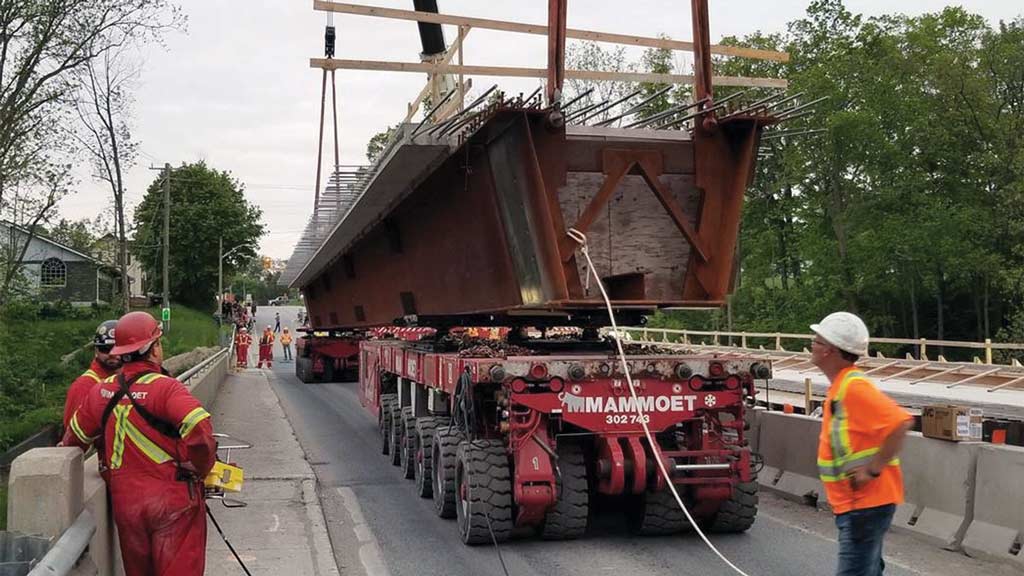Passing through the heart of Southwestern Ontario, Highway 4 is a major collector highway linking several communities including Clinton, Ont. where a new bridge over the Bayfield River was opened last October after only 11 months of construction.
The single-span 40-metre-long, 14.96 metre-wide slab-on-girder steel box girder bridge (with a concrete deck and concrete substructure) was erected using the Ministry of Transportation’s (MTO) GiGo Bridge (Get in Get Out) accelerated bridge construction strategy.
As a result, Highway 4 was only completely closed four times throughout the construction and only for a few hours on those occasions, says MTO’s head of operational services, Frank Lucente.
Designed by McIntosh Perry Consulting Engineers Ltd. and built by McLean Taylor Construction Limited, it replaced the community’s 1932 bridge which had reached the end of its service life.
It was also shifted slightly to better align with the highway geometry and has a one-mere higher profile than the old structure, he says.
Intended to minimize disruption to highway traffic and facilitate early completion of construction, the GiGo delivery system involves the offsite construction of superstructure supermodules, says Lucente.
It isn’t feasible in every situation as each bridge project has to be determined by factors such as specific site conditions, structure considerations, highway geometry, traffic volumes, and staging considerations.
In case of the Clinton project those factors were at play and one was the availability of a parking lot “literally at the end of bridge” which the Ministry was able to secure as the offline staging area, he says.
Construction of temporary abutments to hold the sections began at that staging area in November 2018. As those abutments were being built, the concurrent fabrication of four girders by North Bay-based Central Welding & Iron Works and the parallel production of the precast concrete substructure elements by Decast was taking place.
“That’s the advantage (of GiGo). Construction is simultaneous, not linear.”
In the March of 2019, the sequential delivery of the four girders started, enabling the assembly of the supermodules to proceed. In late April the Stage 1 demolition of the northbound lane (or east half) was completed and immediately afterwards the approximately five-week-long foundation work began. (The foundations are precast abutments on piles.)
Next step in the project occurred on the evening of June 4 when the road was closed at 7 p.m., after which the first supermodule was moved onto the existing roadway and lifted into place by two 600-tonne cranes. Then the second supermodule was dropped into place by approximately 12:01 a.m.
However, it wasn’t until late July that traffic was diverted on to that new east section as long catalogue of tasks had to be completed such as locking the girders together, pouring the concrete for the deck (with an asphalt topping), and building up the road approach, says Lucente.
The same sequencing was used for the southbound lane (or west side). In July the foundation was completed, followed by the placement of the two remaining supermodules on the night of Aug. 22. As was the case with the northbound lane, related work such as laying sidewalks and completing the road approach had to be undertaken. It wasn’t until the end of September that both lanes were opened, with some construction extending into October, says Lucente.
“It (the lift/installation) was quite a sight and it attracted a large number of spectators even though it occurred in the middle of the night,” says Jim Ginn, mayor of Central Huron, which includes Clinton.
While the town did not lobby for the accelerated bridge construction, it certainly helped minimize the inconvenience to the area, says Ginn, who is also the Warden of Huron County.
With more than 5,000 vehicles crossing it every day, the Bayfield Bridge has huge economic benefits to the economy of Clinton and the entire region. Besides regular commercial traffic, large volumes of agricultural crops are trucked over it to reach nearby elevators owned by the Hensall District Co-op, he points out.



Very interesting article, this advanced bridge replacement is incredible. Win, win benefiting everyone ie: community, traveling, economy, workforce, timelines shortened.
The benefit to me personally, the Foreman on this never done before, ground breaking build start to finish our son Christopher Taylor. (no relation to construction company)
Proud parents.